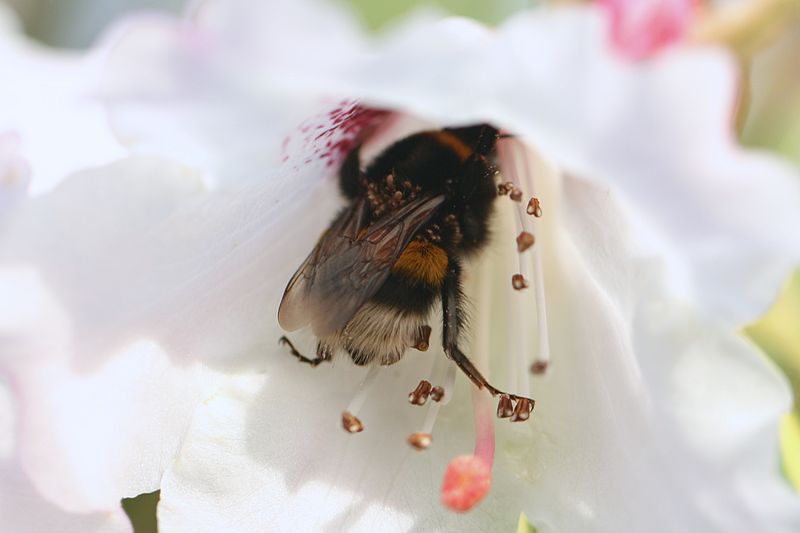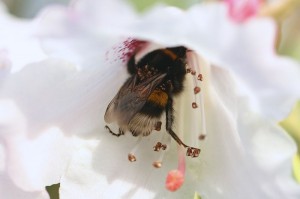Among the multiple pressures currently driving decline in bee populations, little attention has been given to naturally occurring toxins in plant nectar. We carried out research this summer on invasive Rhododendron ponticum, a plant that contains neurotoxins in its floral nectar. We found this toxin to be lethal to honeybees, but apparently benign to the plant’s main pollinators, bumblebees. Differential responses by bee species to toxins and other pressures means we need to consider bee decline on a species by species basis.
It is well documented that bee populations worldwide are in trouble, and we’ve written about this on the blog before. From peer reviewed scientific literature to the August 2013 issue of Time magazine, everyone is talking about declines in bee populations. Bees are important pollinators and contribute to the pollination of 75% of our crop species, which translates to 35% overall global crop production. The downfall of wild and domestic pollinators could pose serious risks for food security and ecosystem function.
Most people agree that the decline of bees can’t be attributed to one specific cause. Instead, multiple pressures such as habitat loss (including loss of forage plants, as well as nesting, mating and overwintering sites for wild bees), and exposure to new diseases and parasites are probably all contributing. One of the suspected drivers of bee decline that has received a lot of media coverage lately is exposure to synthetic pesticides, especially neonicotinoids, which end up contaminating the nectar and pollen of bee-pollinated crops. Surprisingly though, pesticides aren’t the only potentially harmful chemicals bees are exposed to in their food. They also have to cope with natural plant toxins in nectar and pollen. Plants often produce toxic secondary compounds, such as alkaloids, terpenes, and phenolics, to defend against herbivorous insects, like aphids and caterpillars. We humans tend to use many of these chemicals for our own purposes- for example, nicotine (found in nicotiana plants) and caffeine (in citrus and coffee plants). But plant nectar is generally thought to function as a reward for pollinating insects like honeybees. Why then do we find these deterrent chemicals in floral nectar? And how are they impacting honeybees and wild bees? This is a large part of my PhD project, see this old blog post for more detail.
Researchers in the lab of Dr. Jane Stout at Trinity College Dublin are studying drivers of bee decline, and a current project focusses on a plant that contains toxins in its nectar, Rhododendron ponticum. Rhododendron is an ecologically damaging invasive plant in Ireland and Great Britain, famous for the problems it has caused in forest ecosystems in places such as Killarney National Park. This plant grows in moist, acidic soil, and often takes over the understory and edges of forests, shading out other floral resources. The work done at Trinity (in collaboration with Dr. Phil Stevenson at Greenwich University and Dr. Geraldine Wright at Newcastle University) has found that Rhododendron contains a class of toxic chemicals known as grayanotoxins (GTX) in its nectar and pollen. These chemicals are neurotoxins, which block the sodium channels of insects and cause neurological symptoms, like paralysis. To certain insects, this toxin can be lethal.
I am doing a PhD with Dr. Stout and one of my studies is investigating how GTX from Rhododendron nectar affects Irish bees. Together with undergraduate Zoology students Tara English and Sharon Matthews, I’ve performed assays using honeybees, bumblebees, and solitary bees. We fed the bees sugar solutions that are designed to mimic floral nectar, but bees in one treatment are fed solutions containing the toxin and their survival and behavior is compared to control groups, fed solutions containing no chemicals. Surprisingly, the consequences of ingesting GTX from Rhododendron were very different depending on which species of bee was being tested.
Bumblebees can be seen feeding on Rhododendron every May and June in Ireland, and so, as you would expect, they have no apparent negative reaction to consumption of GTX: there was no impact on survival or behavior. Solitary bees are more rarely found feeding on Rhododendron. In the lab, no differences in survival were detected in one species of Andrena, but these bees showed behavioral changes. Bees flipped on their backs and twitched for hours after eating solutions containing GTX. They eventually recovered, but one can imagine that this behavioral response could make them easy targets for predators like birds, and prevent them from foraging and provisioning their nests in their usual way.
Lastly, and most dramatically, were the effects on honeybees. Honeybees showed an almost immediate neurological response to consuming solutions containing nectar-relevant concentrations of GTX: within fifteen to twenty minutes, the bees began twitching and lost antennal function. Some unrolled their proboscis and couldn’t role the tongue-like structure back in, while others regurgitated the liquid as soon as possible. Regardless of their symptoms, within three to six hours, bees fed the GTX solution were dead.
Even though the effect of GTX on honeybee survival is dramatic, compared to the other pressures on the industry, Rhododendron is probably not a huge problem for honeybees. Field surveys by the TCD researchers show that honeybees are not found foraging on Rhododendron in Ireland, even when hives are kept in the middle of a forest invaded by the plant. Honeybees have a remarkable ability to communicate which are the best plants to collect nectar and pollen from, and it’s likely that they quickly learn to avoid this toxic plant. Still, Rhododendron is likely preventing the growth of other plants that might provide forage resources for honeybees, to some extent changing the landscape in an unfavorable way for this species. But our work, in combination with previous work from the Stout laboratory, shows honeybees do not represent the entire ecological story. A study carried out in 2006 and 2007 by Anke Dietzsch showed that the number of bumblebee colonies of two species was higher in areas invaded by Rhododendron when compared to uninvaded control sites in both years. Rhododendron provides a huge amount of nectar and pollen early in spring that this group of bees can take full advantage of. So is Rhododendron good for bees or bad for bees? Turns out it depends what bee species you’re talking about.
The species-specific response to the toxin in Rhododendron nectar is surprising, and emphasizes that not all bees are the same. It’s easy to group these insects into one category, but the impacts of chemicals and other pressures could be very different for each species. It also emphasizes that honeybees are facing many challenges in our changing landscape. Some of these challenges, like habitat change from invasive species and exposure to chemicals, can interact to make the picture even more complicated. Pollinators, including honeybees, need all the help we can provide.
Work on the toxic nectar of Rhododendron ponticum is funded by Science Foundation Ireland, with additional support from the U.S. National Science Foundation, Irish Research Council’s EMBARK Postgraduate Scholarship Scheme, and the Wellcome Trust.


